Mesh
Introduction
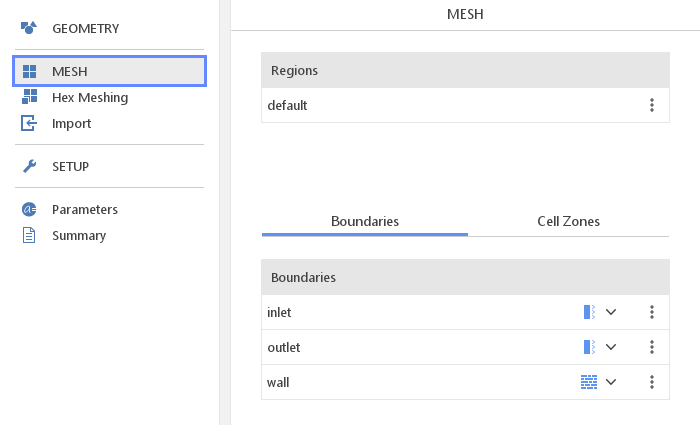
Mesh Panel gives the access to options for modifying and manipulating meshes. Here one can modify mesh regions, boundaries and cell zones in the mesh.
Editing Regions
When a mesh is generated or imported into the program, it is put into the default mesh region. The default mesh region will usually be referred to as Mesh since most simulations are performed using this specific mesh region.
Region Context Options

By clicking on the Options button you can display all the context options available for a given mesh region:
- Check - performs mesh quality checks and displays summary in the console
- Renumber - performs reordering of the mesh to reduce matrix bandwidth and therefore reduce computation time
- Scale - scales mesh region uniformly or non-uniformly
- Translate - moves region along a vector
- Rotate - rotates mesh around an arbitrary axis
- Add Cell Zones - creates cell zone from cells inside specified geometries
- Refine - refines cells inside specified geometries
- Auto Patch - divides region boundaries on sharp edges
- Create Dual Mesh - creates dual mesh from a given mesh
- Cell Zones to Regions - moves cell zone to separate mesh sub-region
- Make sub-region - converts default region to a named sub-region
- Make default - converts sub-region into default mesh region
- Rename - changes the name of a named sub-region
- Delete - removes a given region
Checking Mesh Quality
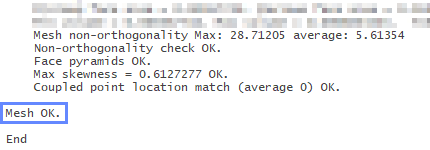
When you select the Check option, the system will gather basic statistics about the mesh quality and print them to the console. If mesh quality is within acceptable bounds, you will see an OK printed in the console. However, if there are some problems with the mesh you will be able to display problematic elements in the graphic window.
Renumbering Mesh
When you apply the Renumber operation, the system will use Cuthill-McKee algorithm to renumber cells in the mesh in order to improve the structure of the solution matrix. This option is useful for large meshes and applying it more than once to a given mesh will usually not bring any improvements.
Scaling Mesh
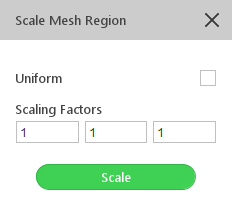
Mesh Scale requires providing Scaling Factors for three directions. If you want to scale mesh uniformly in all directions you can enable Uniform checkbox. After you click Scale the operation will proceed.
Translating Mesh
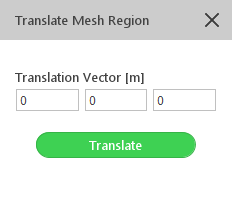
To perform Translate operation you need to provide Translation Vector and click Translate button.
Rotating Mesh
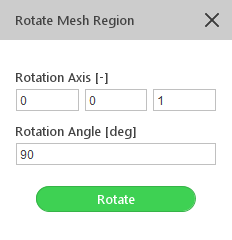
To Rotate Mesh you need to specify Rotation Axis and Rotation Angle in degrees. When you click Rotate the mesh as well as all vector fields will be rotated.
Currently, the mesh can only be rotated around the center of the coordinate system.
Adding Cell Zones
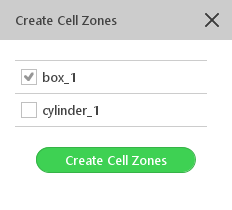
The Add Cell Zones operation will generate a cell zone from cells inside selected geometries. After you select all the necessary geometries and click Create Cell Zones, the system will generate cell zones with names of respective geometries. If there already exist a cell zone with a given name, it will be replaced.
Refining Mesh
Refine operation subdivides each cell inside selected geometries. The Cut Method option controls how the cell that are not aligned with the global coordinate system should be divided.
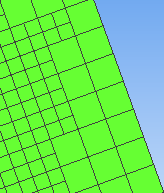
The Hex Topology method is suitable for most applications and will split cells along their local orientation.
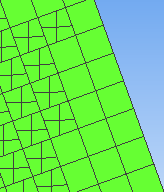
The Geometry Cut will divide cells along coordinate system directions irrespective of the cell orientation.
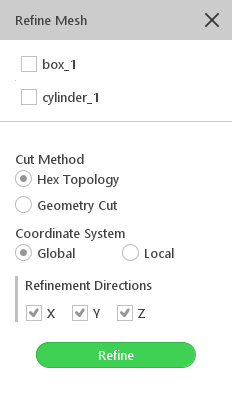
If you use Global Coordinate System the cutting directions will be aligned with the global coordinate system. You have an option to disable refinement on certain directions. This can be useful for example when doing refinement in a 2D simulation. After you click Refine the new refined mesh will be loaded.
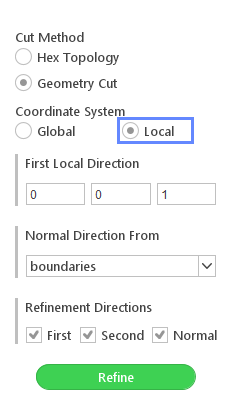
Instead of cutting cells along the global coordinate system you can cut cells along a local coordinate system associated with a boundary. This option is usually useful for refining boundary layers. To set up local coordinate system you need to define First Local Direction which should be tangent to a boundary. Then you need to select a boundary for Normal Direction and optionally disable refinement on certain local directions.
Automatically Patch Boundaries
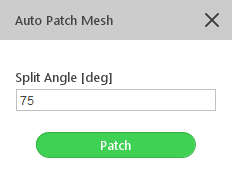
Auto Patch operation allows you to divide mesh boundaries on sharp boundary edges. When an angle between normal vectors of two boundary faces is greater than the Split Angle , the two faces will be put into separate boundary patches. After you click Patch the boundaries of the mesh will be split.
Creating Dual Mesh

Create Dual Mesh operation modifies mesh in such a way that existing cell centers become new nodes and existing nodes become new cell centers. This operation is usually used to convert tetrahedral meshes into polyhedral meshes. Polyhedral meshes usually offer significantly reduced computational time with only minimal reduction in solution accuracy.
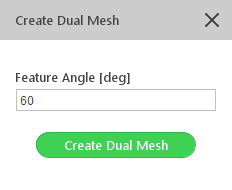
Before you click Create Dual Mesh button you can specify Feature Angle to specify which sharp corners should be preserved by the operation.
Converting Cell Zones To Sub-regions
Cell Zones To Regions will extract cells from cell zones and create mesh sub-region with the same name. This operation is often used for imported meshes since import procedure will put meshes from external formats into the default region.
Converting Default Region to Sub-region

When you want to convert default mesh region to a named sub-region using Make sub-region option, you will be prompted to specify a name for a newly created region.
Converting Sub-region to Default Region
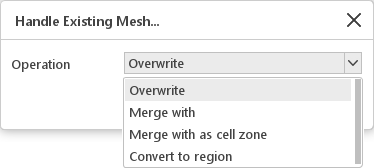
Any mesh sub-region can be make default using Make default option. When there already exists a default region you will be prompted to choose one of possible actions in this situation you can:
- Overwrite - replace existing default region with the moved region
- Merge with - merge the two regions into one
- Merge with as cell zone - merge the two regions into a new cell zone
- Convert to region - move existing default region into a new sub-region
Renaming Mesh Regions
The Rename operation can only be applied to non-default regions.
Deleting Mesh Region
The Delete operation can only be applied to non-default regions. Since this operation is irreversible before it is completed you will be prompted for final confirmation.
Editing Boundaries

Current mesh boundaries are displayed in the Boundaries list. Using this list you can perform various operations on individual boundaries:
1 Change the name by double-clicking in the name area
2 Change the type of the boundary
3 Do advanced manipulations using the context options
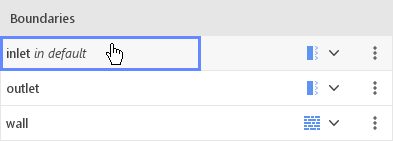
Boundaries from all regions are put in to the list. You can check to which region a given boundary belongs by simply moving mouse pointer over the boundary name.
Changing Boundary Type
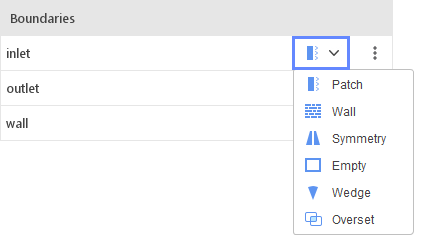
You can change boundary type simply by clicking on the appropriate icon. Setting proper boundary type is essential since it determines how other aspects of the simulation, such as boundary conditions, will be setup. You currently can choose one of five boundary types:
- Patch - general boundary type, typically used for inlets and outlets
- Wall - boundary type that should be used for walls when using turbulence modelling
- Symmetry - boundary type necessary for specifying symmetry boundary condition
- Empty - boundary type that informs solution algorithm that the flow should not be solved in the directions normal to this boundary. This is used to setup 2D and 1D simulations.
- Wedge - boundary type that informs solution algorithm that this is an axis-symmetric simulation.
Boundary Context Options
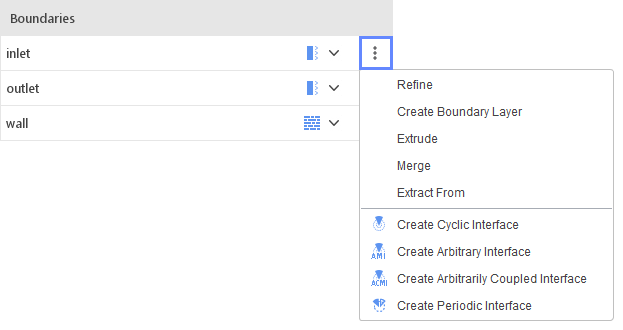
When you click Options button or right-click on the boundary name a context menu with various operations will be displayed:
- Refine - simple operation that refines mesh near a boundary by splitting the first layer of cells in contact with the boundary
- Create Boundary Layer - advanced operation for adding boundary layer refinement on boundaries
- Extrude - operation that extrude mesh from selected boundary
- Merge - operation that takes two or more boundaries and merges them into one
- Extract From - operation that takes a boundary and one or more geometries and extracts all boundary faces inside geometries into a separate boundaries
In the context menu there are also operations of creating mesh interfaces that allow for exchanging information between two boundaries:
- Cyclic - requires both boundaries to have identical shape and mesh
- Arbitrary - requires both boundaries to have identical shape but the mesh does not have to be identical
- Arbitrarily Coupled - interface requires partial overlap of the boundaries
- Periodic - enables conformal mapping of periodic geometries
Refining Cells Near Boundary

Refine operation will split first layer of cells next to a boundary. This operation can be used as a crude way to create boundary layer refinement.
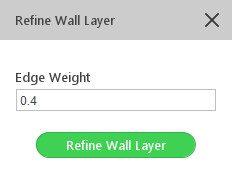
To perform this operation you need to specify Edge Weight which is relative distance from the boundary at which each cell edge should be split. After that just click Refine Wall Layer button.
Creating Boundary Layer
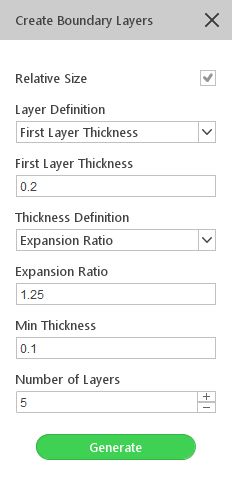
Create Boundary Layer operation allows you to create mesh boundary layer on selected boundaries. This operation allows for much more control than the Refine operation. It also allows to apply boundary layer refinement to more than one boundary.
You can mark Relative Size option unchecked if you want the specification of boundary layer thickness to be absolute instead of relative to the cell size. Layer Definition controls which layer thickness will be defined: first or final. Thickness Definition tells if the thickness is defined by Total Thickness or Expansion Ratio.
You can also control what the minimum size of the boundary layer is allowed. The final control is the Number of Layers. When everything is set properly you can click Generate to start the boundary layer generation process. You should be aware that depending on the size of your original mesh the generation process can take as long as ten minutes.
Extrude Boundary
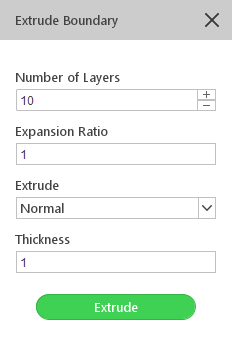
Extrude Boundary allow to modify the existing mesh domain. You can extend the volume by extruding a specific boundary. Mesh extraction is defined by the variable parameters:
- Number of Layers - define the number of additional layers
- Expansion Ratio - define layers distribution
- Extrude - define the direction of extraction which can be orient normal to boundary face or defined by the vector
- Thickness - determine the extraction distance
Merging Boundaries
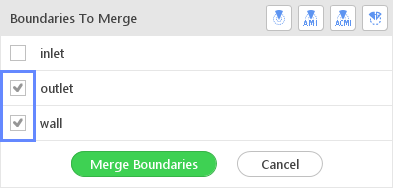
When you invoke Merge operation you need to select all the boundaries that you want to combine. When you click Merge Boundaries a new mesh with merged boundaries will be loaded.
Extracting Boundaries
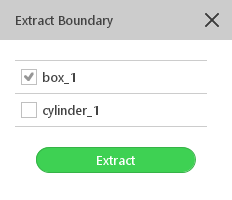
The Extract From operation is enabled only if you have at least one geometry loaded or created. To apply this operation you will have to select one or more geometries. After you click Extract all faces of a boundary that are located inside any of the selected geometries will be put into a new boundary.
Creating Mesh Interfaces
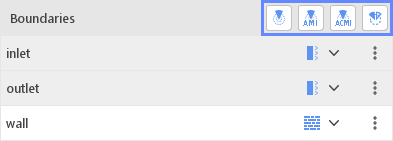
You can create mesh interface by selecting appropriate option from boundary context menu. You also use a quick option by selecting two boundaries in the list and pick a create button that will be displayed in the list title bar.

After you create an interface, the two boundaries that comprise the interface will be removed from the boundary list and an entry representing the interface will be added to the list.
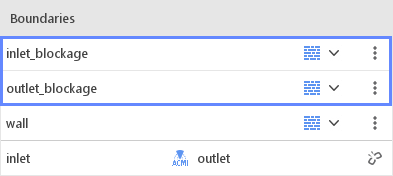
When you create Arbitrarily Coupled Interface two special boundaries will be added to the list. These boundaries represent non-overlapping parts of an interface.
Editing Mesh Interfaces
Different types of interfaces may require you to specify additional properties, for example, define the transformation between interface sides. For certain interfaces, there are additional operations that you can perform. These operations are accessible from the context menu of the specific interface.
Removing Mesh Interface

You can remove an existing interface by clicking Break Coupling button. When an interface is removed the boundaries that comprised the interface will again appear in the boundary list.
Synchronizing Cyclic Interface
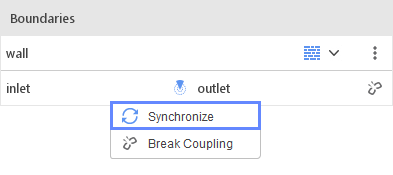
Cyclic Interfaces imposes very strict requirements on the mesh of two boundaries that are being coupled. You need to make sure that the ordering of nodes on each of the boundaries is exactly the same. To do this you can use the Synchronize option available after right-click on the interface.
Mesh Interface Properties

When you select an interface in the list a panel with properties will be displayed. In this panel you can change:
Match Tolerance specifies maximum error in nodes coincidence between boundaries
Transform defines the geometrical orientation of boundaries. Here you can select from several options
- Unknown - boundaries overlap after automatic ordering
- No Ordering - boundaries overlap without automatic ordering
- Rotational - boundaries will overlap after rotation
- Translational - boundaries are separated by some distance
Editing Cell Zones

Cell Zone is a named set of cells. Cell Zones are usually used to define zonal models such as porosity or rotating reference frames. Cell Zones can be edited in the Cell Zones list under Cell Zones tab.
Adding Cell Zones
Cell Zones can be created using context options of Mesh Regions.
Removing Cell Zones

Cell Zones can be removed using Delete context option available in the list.